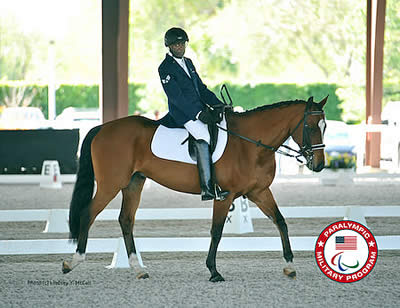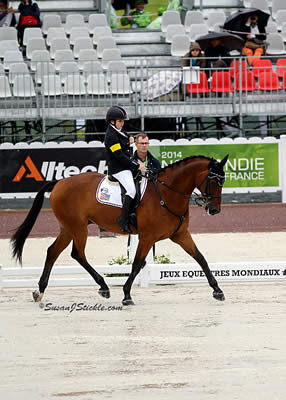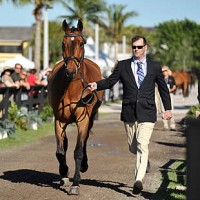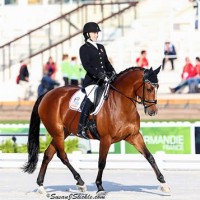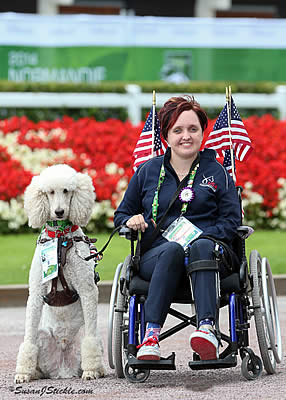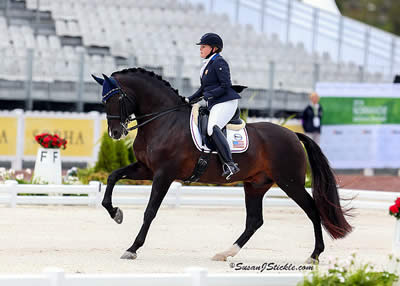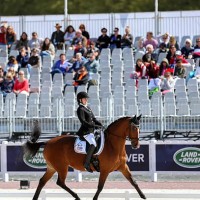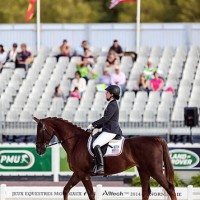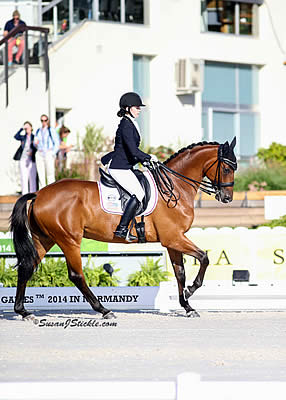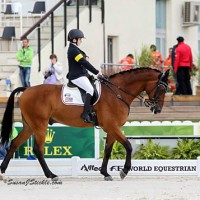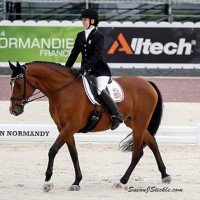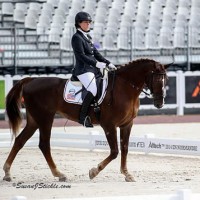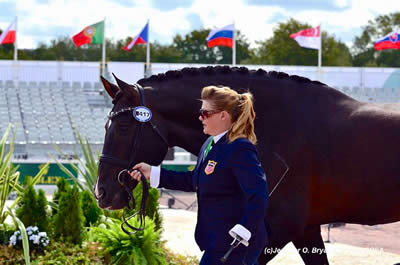Roxanne Trunnell and her own Nice Touch with U.S. Para-Equestrian Dressage Chef d’Equipe Kai Handt at the 2014 Alltech FEI World Equestrian Games. Photo (c) SusanJStickle.com.
Officials are creating a recipe for success at the 2016 Rio Paralympics
In the run-up to the 2012 Olympic Games in London, Great Britain poured £264 million into training programs for elite sports, about 60 percent of which came from National Lottery proceeds. (Source: BBC.com) The results were indisputable: 63 medals, five of which were in the equestrian disciplines, three of those gold.
No matter how talented the athletes, the chances of stepping onto the medal podium are slim without sufficient training and competition opportunities. And that goes double for the equestrian sports, with the high costs of acquiring, maintaining, training, and transporting top horses.
Unlike in Great Britain, equestrian sports in the U.S. typically rely on corporate and private sponsorship to fill the financial gaps. And human nature being what it is, once a discipline or a horse-rider combination begins to enjoy some success, more supporters want to get on the bandwagon.
The sport of para-equestrian dressage is approaching that tipping point, say American equestrian officials and coaches. In this article, we’ll take a look at how U.S. high-performance para-dressage has gathered momentum – and how it’s positioning itself to climb onto the medal podium at the 2016 Paralympic Games in Rio de Janeiro.
Step 1: Hire a Chef
Kai Handt has been the United States Equestrian Federation’s national para-equestrian dressage national coach and coordinator since February. Handt, a German Bereiter and Grand Prix-level trainer and competitor who has owned and operated North Texas Equestrian Center (NTEC) in Wylie, Tex., since 1985, got involved in para-dressage in a roundabout way.
About six years ago, Handt recounts, his (able-bodied) daughter, Julia, “was riding on the junior team for the regional dressage finals, and we had [para-dressage rider] Jonathan Wentz on the team. The team won the gold medal, and he came to our barn. He said, ‘I want to go to the Olympics; I want to do all this stuff.’ I said, ‘Well, what are you going to do for it?'”
Wentz began working at the NTEC, and Handt decided to sponsor him. “He rode three of our horses that we kept for him. We got him to [the 2010 Alltech FEI World Equestrian Games in Kentucky] the next year. The next year, he was US national [para-dressage] champion. He won four Nations Cups and was the best US rider at the [2012] Paralympics. He was very, very close to a medal. He sadly passed away that fall, and then I got approached about becoming the para-dressage national coach.”
Says Handt: “My job at home is to educate all the trainers. The U.S. situation is a little bit unique. The European teams, they are very small countries, so they [each] have one national coach and the riders go on a regular basis to clinics with these coaches. The U.S. is so spread out that everybody has their own individual coach. So I coordinate the trainers and I’m the chef d’équipe at the international events.”
Prior to 2014, Handt says, “We didn’t have much of a [US national para-dressage] program. For London, I believe we had two riders [who were earning scores] in the seventies. We have twelve or thirteen this year. At the national finals [The USEF Para-Equestrian Dressage National Championships], I believe we had 27 [riders] this year.”
Step 2: Gain Experience
Exciting new talent, both human and equine, competed for the U.S.A. at the 2014 WEG – but “new” is synonymous with “inexperienced.”
“We have the youngest rider here of all the [WEG para] riders [16-year-old Sydney Collier]; I think we have the youngest rider the U.S. has ever sent [to an equestrian world championships],” says Handt. “I have all the riders on new horses, so there is really not any pair here with big championship experience. They just need to get some experience under their belly.” (Even Team U.S.A.’s most experienced rider, six-time U.S. para-equestrian dressage national champion and Paralympic veteran Rebecca Hart, is on a new horse this year, the mare Schroeter’s Romani.)
“I think we’re sitting on the right horses; we just need a little bit more ring time, and time for the judges to get to know them,” Handt says. “They’re not well known to the judges yet. They need to go out there and pay their dues and get better known.”
To Handt, the way forward is clear: “We need to get ready for Rio de Janeiro, so we need to majorly cowboy up. We need to compete more so they get calmer about these kinds of competitions. The Europeans have ten, fifteen CPEDIs [FEI-recognized para-dressage competitions] they can go to every year; we have two in Florida and one in California. So we’re trying to get more CPEDI sponsorships so we can get more shows in the United States. I’m working right now with some of the European countries to come over to the U.S. and give them some incentive so we actually compete against the gold medalists. It’s usually just the U.S. and Canada [at the U.S. shows]; we need to compete against the other nations.”
Handt also wants his riders to be able to emulate the other U.S. high-performance squads by traveling to Europe to train and compete. He says he’s hoping for a European tour in 2015.
“Since we’re getting a better team now, and they’re getting competitive, it’s worth it for us to start coming over here and competing in Europe,” he explains.
Step 3: Find the Funding
Which brings us back to where we started this discussion – with the bottom line. Thanks to some recent initiatives, U.S. Equestrian Team Foundation executive director Bonnie Jenkins is sanguine about the subject of funding.
“We’re all really excited about the para-dressage program,” Jenkins says. “The U.S. athletes have performed extraordinarily well, and we’re working hard with the Jonathan Wentz Memorial Challenge that Margaret Duprey and the Barnfield Foundation have made available.” (Duprey and the Barnfield Foundation will each match, dollar for dollar, every pledge of $4,000 and above made through April 1, 2015. For more information, click here: http://uspea.org/category/jon-wentz-memorial-challenge/.
“We feel that, through additional funding, the athletes in this program will really have the opportunity to take off.”
USEF president Chrystine Tauber, who was in the stands with Jenkins for the 2014 WEG para-dressage freestyle classes, observes: “I have attended a few para-equestrian events at home, but seeing it at the international level, you get a very clear picture of how we’re doing in our programs and what needs to get ramped up more.”
“With the additional funding we’re going to be putting in place starting next year, we’re really going to focus on Rio,” Tauber continues. “Just chatting with people, one of the things is how to create this atmosphere at a few more events at home. From the technical side, I think we can work with competition management to give our riders more of an opportunity to compete in [a championships-style venue]. Because some of our horses got a little bit lit up when they came into this stadium.”
The officials’ presence did not go unnoticed.
“I’m very thankful and impressed that the USEF sent a lot of their staff, and the able-bodied dressage trainers and coaches were all excited about coming over this year to catch some of the rides,” says former Paralympian and current U.S. Para-Equestrian Association president Hope Hand. “To have them see firsthand the quality of rides, it’s very important to take all that back to our federation. That will mean a lot to us, getting that support and exposure.”
Says Tauber: “With [veteran sports-management and development executive] Chris Welton coming in as the new [USEF] CEO, we’re hoping to really step up the sponsorship levels. That’s one of our main focuses: to bring up the level of sponsorship dollars that goes back into high performance. That should have an effect on all disciplines, but certainly on para as well.”
In recent years, a lot has been written about the USEF’s establishment of high-performance tracks, or “pipelines,” to develop new talent in eventing, jumping, and dressage. Designated national coaches do scouting and conduct clinics, among other duties.
Currently there is no USEF para-dressage pipeline program, but such a program “certainly can be” established, says Tauber. “That’s a question of having our coaches start to put together those specific programs, because that’s what our three Olympic coaches have done. They actually created the pipeline, and that is clearly working. We need to probably use that model across the board.”
Another key new hire – one that Tauber says will prove “a major turning point in all our programs” – is that of Will Connell. Connell, a native of Great Britain, has served as the British Equestrian Federation’s sports director since 2003. After he concludes his commitment to Team GB when the 2014 WEG wraps, Connell will immigrate to the U.S. to start his new job as USEF director of sport programs October 1, based at U.S. Equestrian Team Foundation headquarters in Gladstone, N.J. He succeeds former USEF director of sport programs Jim Wolf.
“He is the one who put together that phenomenal sports program for Great Britain, and we saw the results of that in London,” Tauber says of Connell. “I think this is going to have a dramatic impact on our future plans and our development programs because he has already proven that he can create the programs and produce the results we need.”
Delicious Possibilities
“I think it was really a positive experience,” Hand says of the 2014 WEG. Of the U.S. para-dressage riders, she says: “I think they did very well. Everybody got very respectable scores. They performed well as a team, they helped each other, and they got through some very tough competition.” As the largest-ever para-dressage competition at the WEG – 19 teams and 100 horse-rider combinations from 33 nations – “the field was so competitive, and to get two of our riders qualified for the freestyle was significant and important to us.”
As Handt sees it, para-equestrian dressage is a sport whose star is rising – and he plans to ride the wave.
“The Paralympics is the second-biggest sporting event in the world,” he says, and “the Paralympic movement is really moving up as far as status goes. Obviously, for a sponsor, the image is fantastic: How much better an image can you have than to sponsor a physically disabled person who is actually an Olympic competitor?”
Take the feel-good para-equestrian message and stir in some good old-fashioned American patriotism, and the result may well be not only irresistible to sponsors but also a source of growth for the para-dressage program.
“We’re working a lot without veterans. I actually have a U.S. Air Force veteran who is competing and was long-listed for here. We’re even working with the Wounded Warrior Project,” says Handt, referring to the veterans service organization that supports injured post-9/11 U.S. military veterans (WoundedWarriorProject.org).
The positive impression that the 2014 U.S. WEG para-equestrian dressage athletes left on VIPs and the equestrian public alike is “what we need to further the sport and get it out there that they’re serious athletes, not much different from [those in] able-bodied dressage,” says Hand. “They’re very focused and very athletic and have the same challenges that we all do in the sport.” And with the right mix of talent and support, it will be exciting to see how far they can go.
By: Jennifer O. Bryant for the USPEA
Learn more about the Para-Dressage discipline at the 2014 Alltech FEI World Equestrian Games™ in Normandy, France: http://www.normandy2014.com/the-disciplines/8/para-dressage.
Support the Team and its future to the 2016 Paralympics in Rio with the USET Foundation’s Jonathan Wentz Memorial Challenge: http://uspea.org/the-jonathan-wentz-memorial-challenge/.
Learn more about the U.S. Para-Equestrian Dressage discipline or give a tax-deductible donation to support the development of the sport with the USPEA 501(c)(3)t: www.USPEA.org.
About United States Para-Equestrian Association:
The USPEA is a network of riders, judges, national federation board members, and equestrian enthusiasts. The association gives athletes the ability to get involved and expand their knowledge and experience in the Para-Equestrian sport. The USPEA encourages para-athletes to participate in all disciplines under the para-equestrian umbrella.
The USPEA is a recognized affiliate of the United States Equestrian Federation (USEF) which serves as the National Governing Body for the equestrian sport. This relationship between the USPEA and USEF is to encourage para-equestrian competitors, leisure riders, coaches, fans and enthusiasts to network and get involved with the entire equestrian sport.
Ultimately the goal of the USPEA is to foster growth in the para-equestrian discipline. From growth in the number of participants to growth as a team, and growth in the experience and knowledge of all involved. From local horse shows to international Olympic Games, the USPEA will provide para-equestrians the knowledge of what they need to succeed. The USPEA connects with the International Olympic Committee (IOC), the Federation Equestre Internationale (FEI), the United States Dressage Federation (USDF), and USEF which provides Para-Equestrians the top equestrian resources.
In June 2010, the USPEA earned its 501 (c)(3) status which has encouraged supporters to help supply funding to the Para-Equestrian Team as a recognized affiliate of the United States Equestrian Federation (USEF).
For more information about the USPEA, please visit www.USPEA.org or contact USPEA President Hope Hand by e-mail: Wheeler966@aol.com or by phone: (610)356-6481.
